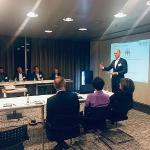 I had the unique opportunity to join 25 finance professionals of the San Francisco FP&A Board to have a robust dialogue on how to build winning FP&A teams. As a senior finance leader, I found the discussion to be very informative as well as touching on many of the challenges I faced while building strong finance teams. A very special thank you to our event sponsors Robert Half and SAP for making this forum possible. I would also like to thank Valerie Martin, Finance Director at Autodesk, and Matt Padfield, Vice President of FP&A at Synaptics, for sharing their insights with us.
I had the unique opportunity to join 25 finance professionals of the San Francisco FP&A Board to have a robust dialogue on how to build winning FP&A teams. As a senior finance leader, I found the discussion to be very informative as well as touching on many of the challenges I faced while building strong finance teams. A very special thank you to our event sponsors Robert Half and SAP for making this forum possible. I would also like to thank Valerie Martin, Finance Director at Autodesk, and Matt Padfield, Vice President of FP&A at Synaptics, for sharing their insights with us.
Finance teams are quickly transitioning from traditional “accounting/bookkeeping” roles to business partners integral to shaping corporate strategy through robust financial analysis. The issue that many FP&A professionals face today is how to build a team that is technically proficient in accounting standards but can also quickly digest figures and trends to tell a story that is relevant to influencing, driving and achieving corporate goals.
So long are the days of building reports in the sanctuary of familiar excel models and Bi Tools and throwing them over the proverbial cubical fence. Finance teams need to be embedded and engaged in the business to truly create value. The San Francisco discussion was focused on how to build that world-class FP&A team. One key takeaway was that we should not focus on finding candidates or pushing team members to tick all the boxes, but focus on the team collectively to meet core competencies required of a world-class team.
What are the key features of a successful FP&A Professional?
We were asked to reflect on what kind of attributes make up a well-rounded FP&A professional. After a round table brainstorm, those attributes include: influential, realistic, business-oriented, trust, accuracy, strategic-thinker/partnership/collaborative, curiosity, impactful/catalyst, disciplined, flexibility, future-oriented and insightful. These are all combinations of quantitative/qualitative and backward- / forward-looking attributes.
The second question was, how difficult is it to find talent that ticks all the boxes? The answer was challenging and quickly the group concluded that it is not imperative to find a team where each member exudes all these attributes. Quickly the discussion moved to how diverse teams (in background, expertise, and experience) can address this challenge as well as build team flexibility to meet evolving corporate needs.
FP&A Team Building: FP&A Team Roles
Mark Gandy, Outsourced CFO, Principal at G3CFO, suggests in his article, Three Critical Roles for Every FP&A Team (2018), that diverse team roles is one formula to building strong teams. Gandy’s 3 core roles plus 2 additional roles are: The Architect, The Data Scientist, The Analyst, The Storyteller and The Influencer. It’s important to have diversity in the team. Moreover, it’s important to note that each role need not to be filled by just one person, and no one role is superior or more important than another. You need all the pieces of the puzzle for the team to function.
Team-members can play several roles – which one board member said was important to ensure that people can cover for each other. It is also important to be cognizant that not all data-scientists can be stretched to become storytellers or vice-versa. Managers need to recognize their team’s strengths, back fill in weaknesses and stretch those who have the potential to move from one role to another.
The discussion then focused on 2 case studies where Valerie Martin and Matt Padfield presented their unique approaches to leveraging a melting pot of talent to a world-class tea.
Case Study 1: Valerie Martin, Finance Director at Autodesk
Autodesk has embarked on a culture change centered on “courage”. Valerie’s team has launched a behavior-driven culture code to foster an environment to be smart, adaptable, impactful and innovative. The culture is reinforced through workshops, managing current and emerging talent (manager boot camp, how to add to the culture where each role is important), adapted finance leadership style & structure (breaking down silos) and psychological safety (encourage team creativity, open environment and what is OK to risk).
Her team has collectively agreed on the “way we work” and how to reward and recognize “culture heroes”. This concept of recognizing “culture heroes” particularly struck me as an absolute essential, however often overlooked, ingredient to world-class teams. Recognition is so easy to do, but easily overlooked as not a priority or not appreciated. We should all take Valerie’s lead to give recognition where recognition is due.
Case Study 2: Matt Padfield, VP FP&A at Synaptics Incorporated
Matt had a unique approach to team-building by defining an impactful culture. In setting expectations, it's beneficial to start with the “why” and follow with the “how” and “what”. Tell your team that it’s ok to try something new. This all ties into messaging your team’s core values.
The “Why” is about your Purpose – Why does the company exist? Why do I do what I do? Why should anyone care?
The “How” is about your process / how you get there – specific actions you need to take to achieve your Why.
The “What” is the outcome and proof of your purpose – The Why.

His next visual is what he coins as the Pyramid of Financial Awesomeness. Where the reporting of data is the foundation, building upwards to where FP&A teams should strive to be, business partners and trusted advisors. To get to the top of that pyramid, you need to have a rockstar team.

Team assessment is the last area that Matt touched upon. He uses a modified Nine-Box method to assess and to a build roadmap on any changes or adjustments he needs to make. Although time-consuming, he recommends that all managers invest time to sit down with individually with team to quickly assess where they fall in his modified nine box. Being mindful that if your organization is in transformation, which all too many of us are experiencing today, it is imperative to add a 3rd layer of willingness to embrace change or direction of change.
Lessons Learned and Takeaways
This month’s board meeting was a fantastic exchange of experiences, approaches, commiseration of pain-points and a lot of ideas to build out that Rockstar FP&A team. We need to remind ourselves that diversity is essential – everyone has a role to play and those roles are equally important. Leaders need to drive through a culture of expedited evolution, courage, creativity and accountability all centered on “Why” we get up each and every morning to do what we do. I look forward to the next FP&A Board Meeting to be held in the Fall. Until then, I wish everyone to stay safe and healthy during this new time of crisis.





